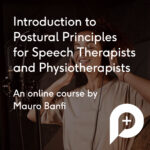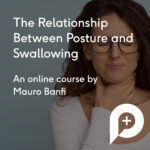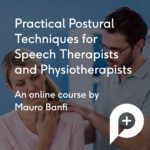Enhance your interdisciplinary practice with a detailed understanding of posture and how it relates to speech, signing and swallowing.
Everything you learn in this course will transform your understanding of what’s possible when Physiotherapists and Speech and Language Therapists work together. We’ve specifically made this programme to enhance MDT collaboration.
The knowledge and techniques you’ll gain from taking part is ready to use immediately in any setting, everything is easily adopted to sitting or standing positons. If you’re wondering why that’s improtant to know you’ll have to take part to find out.
The Tutor – Mauro Banfi
 Mauro Banfi is a Physiotherapist since 1992 and Osteopath since 2000. Mauro works as a professional Osteopath and Physiotherapist in the field of sport, acrobatic and performing arts with a particular interest in artistic voice problems, in cooperation with speech therapists, ENT specialists and conservatories of music.
Mauro Banfi is a Physiotherapist since 1992 and Osteopath since 2000. Mauro works as a professional Osteopath and Physiotherapist in the field of sport, acrobatic and performing arts with a particular interest in artistic voice problems, in cooperation with speech therapists, ENT specialists and conservatories of music.
For well over two decades he provides sessions and courses for performers, manual therapists, osteopaths and speech therapists to improve their manual skills in the treatment of the patient artist.

The Programme – Postural Principles for SLT & PT
Postural Principles for SLT and Physio Programme

This programme aims to demonstrate the relationship between posture and other systems, such as speech and swallowing. Through a detailed discussion of postural principles, you will learn about the most frequent causes of postural dysfunction. You will then be introduced to effective assessment and treatment strategies that will enable you to better manage patients with postural dysfunction.
Enhance your MDT Practice
The Courses – Three Course Programme
Postural Principles for SLT and Physio Programme

The relationship between posture and speech is well recognised. Changes in posture have a direct impact on vocal performance and patients with dysphonia often present with specific postural dysfunctions. If these postural anomalies and associated muscular compensations are not addressed, singers may have ongoing issues with their performance. This course, therefore, provides an in-depth discussion of posture and specific principles that can be used to manage postural dysfunction.
Understand The Link Between Posture & Performance
The Relationship Between Posture and Swallowing

Deglutition, or swallowing, is an essential physiological function that allows food to travel from the mouth to the stomach. Our ability to swallow changes as we age and can be affected by a number of conditions, including neurological disorders such as stroke, multiple sclerosis or ALS. Posture can also affect swallowing and, in turn, can be affected by swallowing. Having an understanding of the relationship between swallowing and posture is, therefore, essential when assessing patients who have difficulties with deglutition.
Explore The Relationship Between Posture & Deglutition
Practical Postural Techniques for Speech Therapists and Physiotherapists

There is a known link between posture and vocal quality, as well as posture and swallowing. When working with speech therapy patients, it is essential to have the skills to evaluate the relationship between posture and these functions. This course will introduce specific methods that can be used to assess and address postural dysfunction. The techniques discussed in this course focus on standing and sitting postures that can be easily adopted in speech therapy practice.
Learn Practical Skills to Enhance Your Practice
 Mauro Banfi is a Physiotherapist since 1992 and Osteopath since 2000. Mauro works as a professional Osteopath and Physiotherapist in the field of sport, acrobatic and performing arts with a particular interest in artistic voice problems, in cooperation with speech therapists, ENT specialists and conservatories of music.
Mauro Banfi is a Physiotherapist since 1992 and Osteopath since 2000. Mauro works as a professional Osteopath and Physiotherapist in the field of sport, acrobatic and performing arts with a particular interest in artistic voice problems, in cooperation with speech therapists, ENT specialists and conservatories of music.



